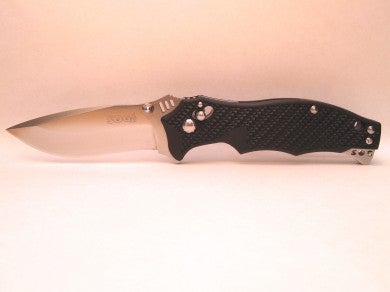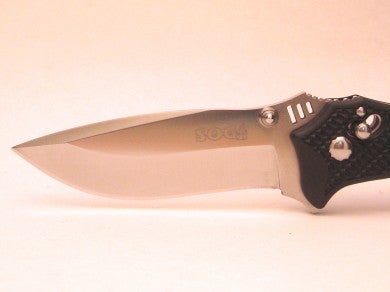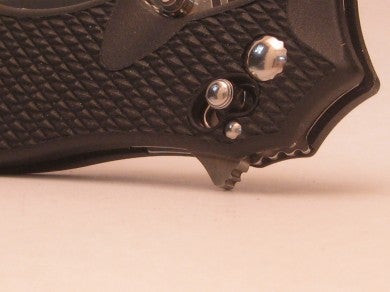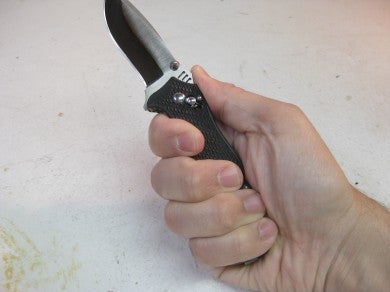SOG Vulcan Mini
Tony Sculimbrene 08.05.13

SOG is a company with something of a history. They made their name with excellent reproductions of Vietnam fixed blades. Their initial folder, the Tomcat, was a success right out of the gate, winning the Blade Show Overall Knife of the Year in 1988. They are one of the few knife brands that have made it into the world of Big Box retailers and still sell things that cater to the enthusiast crowd. Straddling that line is incredibly profitable but very difficult. Big Box wants you to sell bulk and in cheap. The enthusiasts want high-end materials, refined fit and finish, and a sense of exclusivity. One of the other brands that tries to straddle this line, Gerber, has almost completely failed. Their enthusiast stuff is unpopular, rarely discussed, and almost all legacy models from before the Fiskars take over. Their mainstream stuff has been subject to more recalls than seems possible, making them the Corvairs of the gear world.
Description
This is a review of a knife, the SOG Vulcan Mini, that clearly plays more in the enthusiast camp. There are a few variations: a tanto point and a black bladed version. There is also a larger version, the Vulcan. The Vulcan Mini clocks in around $90-110 on the street, significantly less than MSRP. It carries a nice, though not leading edge steel, VG-10. The lock is an Arc Lock, which is ambidextrous lock capable of bearing fantastic loads. The knife has thumb studs, but this is really a flipper design. The pocket clip is made for deep carry. The overall size is roughly similar to the Benchmade Mini Grip (slightly larger) and the Kershaw Skyline. This is a solid and slightly heavy knife because of the full stainless steel liners.
Testing
It is really easy to test knives of this size. Drop it in your pocket for a week or two and see what happens. That is what I did with the Vulcan Mini. But on Sunday my workshop vacuum decided that I was babying the Mini Vulcan too much and crapped out on me. I took the filter and the filter bag apart with the Vulcan Mini, cutting through cardboard, a year of shop debris, and other nameless disgusting filth. Eventually I got the vac working again (my son had dropped a rag into the vac and it got lodged around the motor housing), but I did a number on the Vulcan Mini. There was crud in places I doubt the designers ever intended to be and the blade looks pretty shabby. The combination of hacking free the working parts of my vac and regular EDC tasks were the main testing tasks for the Vulcan Mini, and while I intend to always use the knives I carry, the vac task was pretty awful and perhaps unfair. After a thorough cleaning, using some Goo Gone to restore the luster of the blade, a quick shot with some pressurized air, and some Nano Oil, the Vulcan Mini was all but back to new.
Design
The overall look of the knife is very aggressive. The Vulcan Mini, like virtually all of SOG’s knives, is a Spencer Frazier design. His design touches are evident in the handle shape–scallops, fins, and muscular curves. The knife has a very organic, aggressive, look and shape. The combination of the Arc Lock and the flipper are tough to pull off together. More on that below.
The materials here are decent, though a little below par for the price range. The handle is an FRN or FRN-equivalent. The blade is a VG-10, a very corrosion resistant steel capable of taking a fine edge but somewhat lacking in the edge retention department. It does not seem to roll or chip to any problematic degree. Some folks might balk at the lack of G10 or Micarta, but I don’t really see how G10 or unpolished Micarta is all that different of FRN. I’d take the weight savings of the FRN type material any day over the supposed premium G10 and Micarta represent.
One big issue is the liners. They make this knife heavy. It is not a de-pantser, but it is heavier than it needs to be for the size of knife that it is. I’d like to see milled out liners or an abandonment of liners altogether. The Cold Steel Mini Recon performs quite well, even in the hardest use tasks a folder can reasonably be asked to perform, and it does so without liners.
Implementation
I have said this in reviews I have done of SOG knives in the past and it is true with the Mini Vulcan in spades–they do the best grinds of any production company out there. Some folks are equal, none are superior. The Vulcan Min’s grinds are quite simply unquestionably great. The cutting bevel is wide but not too wide and perfectly even. The hollow grind is excellent and the swedge makes the point stout but plenty pointy. This is a Seki City made knife and the heritage of the place of origin is readily apparent. This is a masterfully finished knife from a region known the world over for their cutlery making skill.
The fit and finish elevates the merely average VG-10 steel to something much better. Over time I have learned that superior fit and finish can squeeze the last bits of performance out of materials and here, the VG-10 does very well. I really did think I had ended the functional life of the blade with the vac repair, but as it turns out, nothing could be further from the truth. Some maintenance quickly brought the blade back to this:
I can’t say that I am a fan of the slight recurve, but a few passes on the Sharpmaker convinced me that it’s not a complete and utter pain to sharpen. That said, I’d prefer a simple straight bottom to the blade, as recurves can rarely justify themselves in normal EDC tasks. One other point of note: that thumb ramp on the spine of the blade really is a little too pointy. It is nothing crazy, but just a bit too much. Finally, there was a smidgen of blade play as the knife was shipped, but a few rotations of the pivot screw and it was gone. Plus the knife still came out smooth after that.
Function
The knife has a deep carry pocket clip typical of SOG blades. Some people like it, some people don’t. Personally I don’t care. This is a decent but not great clip. In the pocket I would have preferred no steel liners, but the knife is not overly heavy, coming in around 3.4 ounces, quite good for a blade this robust.
The flipper is similar in performance–good but not great. Actually, it is probably closer to very good. You see, the shape and size are just right:
But there are problems inherent in flipper designs and Arc/Axis locks. Two knives I reviewed for my site, the Bluto and the Benchmade 300SN, had similar configurations and the flippers were sluggish to say the least. The problem is that the physics of a flipper requires a stout detent that is best created by a frame lock or liner lock. That said, the Vulcan Mini is easily the best flipper of the three. Again, I think this comes back to the level of polish and expert finish on the blade. Everything simply works just a little better because of those folks over in Seki City.
The lock is an excellent lock. I found it did well with static and non-static loads (i.e. steady pressure or “whack the hell out of that thing” pressure). It was easy to engage and disengage. There was very little in the way of stability problems. The Arc lock is simply a very refined design and it was well implemented here.
In the hand and pocket the knife was fine. Here it is in my mitt:
I wear medium sized hands and I was trying to hold the knife so it was clear what blade it was in the picture, but in use I found the handle especially comfortable. The scallops work well and the convex handle scales and tapered rear of the grip all make for an excellent knife when working. Amazingly, my grip matched up with the pocket clip well and there were very few hotspots.
Conclusion
The appearance of the Vulcan Mini is pretty extreme. You will either like the aggressive organic appearance or not. But even if you don’t, looking through that will reward you. This is a well made knife with an excellent lock, decent steel, and really superb fit and finish. Next to my Benchmade Mini Grip, the Vulcan Mini’s blade gleamed with Seki City perfection. Milled out liners would be nice, but overall this is a good knife and worth a look if you are in the market for a 3 inch EDC knife. Its pricey for the materials, but all of that polish comes from costly, skill- and labor-intensive work by those masters of the form in Seki City.



